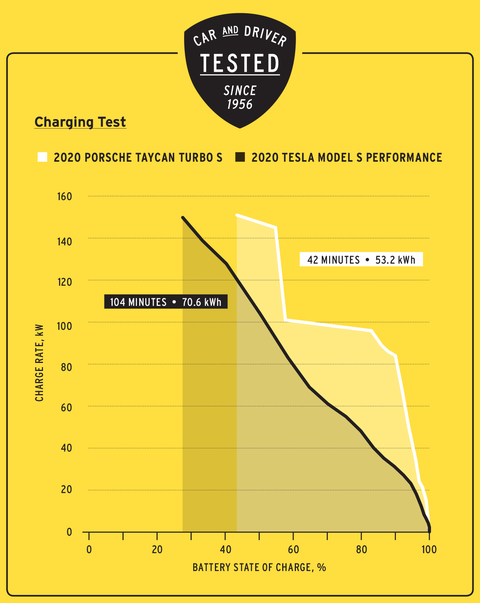
Marc UrbanoCar and Driver
- Porsche claims its new Taycan EV can charge at a rate of 270 kW, a new record, which requires plugging in at one of Electrify America’s latest 350-kW units.
- Tesla is also rolling out higher-output 250-kW V3 Superchargers.
- We tried each car’s fastest fast charger to compare the charge rates between a Tesla Model S and a Porsche Taycan.
When it comes to acceleration, electric cars are already as swift as just about anything else out there. The next frontier is how rapidly they can be recharged, a key enabler to making road trips more palatable, and an area that Tesla has dominated to date with its nationwide (and worldwide) Supercharger network.
But Porsche claims a new record maximum charging rate on its new Taycan, a whopping 270 kW when using Electrify America’s latest DC fast chargers, which are capable of pumping electricity at up to 350 kW. That’s more than double the mainstream 150-kW Tesla Superchargers, although V3 units are rolling out, which raise the peak to 250 kW (the maximum the Model S can accept, however, is 200 kW). Even so, there’s still a long way to go, as pumping 15 gallons of gas in five minutes equates to a fill rate of just over 6000 kW.
Peak charging rates are not terribly informative, though, as they tend to happen for a very short period of time, and only if the battery is nearly empty when starting the charge. So, as part of our comprehensive comparison test between the Porsche Taycan Turbo S and Tesla Model S, we visited each model’s quickest charger, which is easier said than done, as both are extremely rare today. Even in the greater Los Angeles area, where we conducted our test, which has more EV density than most American cities, there are only one of each: an Electrify America unit in Burbank, and a V3 Supercharger at Space X’s Hawthorne, headquarters.
This wasn’t exactly a laboratory-grade scientific test, as the Taycan’s battery was just above 40 percent and the Model S’s was at 30 percent at the start of charging. That means neither were depleted enough to achieve the headline peak-charging numbers. Both topped out right at 150 kW. However, the Taycan set itself apart by keeping its charging rate much higher later into the charge, which is shown by our accompanying chart. The Porsche didn’t dip below 50 kW until the battery was 94-percent charged, while the Tesla dropped below that rate at 80-percent capacity.
In total, the Taycan took 42 minutes to dispense 53.2 kWh of energy, while we waited 104 minutes to pump 70.6 kWh in the Model S. That’s an average charge rate of 76 kW for the Porsche and 41 kW for the Tesla. Granted, both figures are slowed by our wanting to track the rate of charge all the way to 100 percent, and that last few percent takes a long time (for example, going from 95 to 100 percent charge in the Model S added 40 minutes).
We suspect the Taycan’s primary reason for being able to charge so much more quickly is its 800-volt electrical architecture, which is twice the EV norm. The 350-kW Electrify America stations also operate at 800 volts, and the fact that the voltage is twice as high means that half the current is required to achieve a given rate of charge. We’re interested to see if the Porsche’s advantage erodes if instead using lesser, and far more common, 400-volt charging equipment, an experiment we plan to undertake at a later date.
A further bonus to anyone who’s experienced a crowded Supercharger lot: there wasn’t another car charging at any of the row of 15 plugs the entire time we were there. However, you’ll pay for it, as the Electrify America chargers are far more expensive to use. The cost is based on the maximum charge rate the car can accept, not what’s actually achieved. So, the Taycan pays the highest rate—a dollar a minute—no matter how much energy is flowing. Our charging session cost $43, which is more than five times the going rate in California for the amount of energy we consumed, and more than double what Supercharging costs.
Source: Reviews - aranddriver.com







